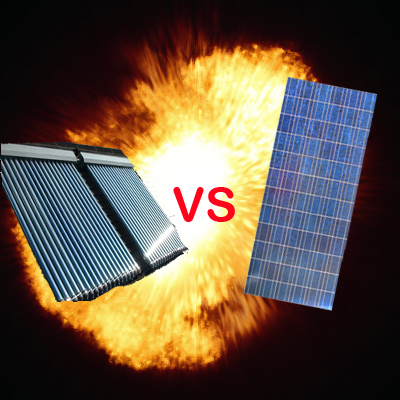
Is there competition within the solar industry, between photovoltaics and thermal technologies? Or is it more like one beast, with two heads, talking to itself? Perhaps that’s a bit farfetched. Let’s go with this: two friends, working toward the same end, who will have to learn to work together to achieve their goals.
First off, let’s clarify the difference between the two. Solar thermal captures the sun’s heat, which is then distributed through the home. Photovoltaic panels convert the sunlight directly to electricity and use it to power the home. Now, looking at the numbers, it would seem that solar thermal has the obvious advantage over solar PV, for a few reasons.
- Efficiency. Thermal solar collectors capture up to 70% of the sun’s heat for use in the home. Solar PV panels convert, on average, only 12% of sunlight into electricity.
- Size. A rule of thumb for solar energy; there is 1kW of solar energy available for every square meter. This translates into 3400 BTU/hr/square meter. Now, at 70% efficiency, you only need approximately 42 sq. meters of collectors to produce 100,000 BTU/hr. This is the equivalent of the heat generated by a typical gas furnace.
- Cost. Thus, you would need less space and less solar thermal collectors, which are inherently much cheaper than PV panels anyway, to fulfill your heating needs. Here you have a scenario in which you have a system that is 6 times more efficient and 5 times cheaper than its rival.
So why doesn’t solar thermal dominate?
Give me one good reason, you might say, why SpongeBob SquarePants isn’t installing a solar thermal system on top of his pineapple. Here are a couple:
- Storage. Heat is very difficult to store without some sort of thermal mass. Thermal mass walls or floors are a common feature of passive solar homes. However, it is exceedingly difficult to retrofit such a wall after the home is built. So retrofit systems must be active systems and will require large storage tanks which can be difficult to fit to your exact needs.
- Year-round Use. Perhaps the biggest advantage for solar PV is that is remains relevant throughout the year. Thermal space heating systems can sit unused for up to six months during the summer. While PV continues to provide usable electricity year round.
For these reasons, solar PV still dominates America’s solar rooftops. However, solar thermal hot water systems are an excellent, very cost-effective, way to supplement energy bills. Water heating, after all, is the second biggest user of energy in the home; behind space heating. Not only that, there have also been recent innovations in solar thermal.
Links: